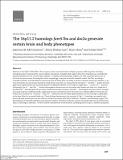| dc.contributor.author | McCammon, Jasmine M. | |
| dc.contributor.author | Blaker-Lee, Alicia | |
| dc.contributor.author | Chen, Xiao | |
| dc.contributor.author | Sive, Hazel L. | |
| dc.date.accessioned | 2018-07-10T14:50:13Z | |
| dc.date.available | 2018-07-10T14:50:13Z | |
| dc.date.issued | 2017-07 | |
| dc.date.submitted | 2017-06 | |
| dc.identifier.issn | 0964-6906 | |
| dc.identifier.issn | 1460-2083 | |
| dc.identifier.uri | http://hdl.handle.net/1721.1/116865 | |
| dc.description.abstract | Deletion of the 16p11.2 CNV affects 25 core genes and is associated with multiple symptoms affecting brain and body, including seizures, hyperactivity,macrocephaly, and obesity. Available data suggest thatmost symptoms are controlled by haploinsufficiency of two or more 16p11.2 genes. To identify interacting 16p11.2 genes, we used a pairwise partial loss of function antisense screen for embryonic brainmorphology, using the accessible zebrafish model. fam57ba, encoding a ceramide synthase, was identified as interacting with the doc2a gene, encoding a calcium-sensitive exocytosis regulator, a genetic interaction not previously described. Using genetic mutants, we demonstrated that doc2a+/-fam57ba+/-double heterozygotes show hyperactivity and increased seizure susceptibility relative to wild-type or single doc2a-/-or fam57ba-/-mutants. Additionally, doc2a+/-fam57ba+/-double heterozygotes demonstrate the increased body length and head size. Single doc2a+/-and fam57ba+/-heterozygotes do not show a body size increase; however, fam57ba-/-homozygous mutants show a strongly increased head size and body length, suggesting a greater contribution from fam57ba to the haploinsufficient interaction between doc2a and fam57ba. The doc2a+/-fam57ba+/-interaction has not been reported before, nor has any 16p11.2 gene previously been linked to increased body size. These findings demonstrate that one pair of 16p11.2 homologs can regulate both brain and body phenotypes that are reflective of those in people with 16p11.2 deletion. Together, these findings suggest that dysregulation of ceramide pathways and calcium sensitive exocytosis underlies seizures and large body size associated with 16p11.2 homologs in zebrafish. The data inform consideration of mechanisms underlying human 16p11.2 deletion symptoms. | en_US |
| dc.publisher | Oxford University Press (OUP) | en_US |
| dc.relation.isversionof | http://dx.doi.org/10.1093/HMG/DDX255 | en_US |
| dc.rights | Creative Commons Attribution-NonCommercial 4.0 International | en_US |
| dc.rights.uri | http://creativecommons.org/licenses/by-nc/4.0/ | en_US |
| dc.source | Oxford University Press | en_US |
| dc.title | The 16p11.2 homologs fam57ba and doc2a generate certain brain and body phenotypes | en_US |
| dc.type | Article | en_US |
| dc.identifier.citation | McCammon, Jasmine M. et al. “The 16p11.2 Homologs Fam57ba and Doc2a Generate Certain Brain and Body Phenotypes.” Human Molecular Genetics 26, 19 (July 2017): 3699–3712 © 2017 The Author(s) | en_US |
| dc.contributor.department | Massachusetts Institute of Technology. Department of Biology | en_US |
| dc.contributor.mitauthor | Chen, Xiao | |
| dc.contributor.mitauthor | Sive, Hazel L | |
| dc.relation.journal | Human Molecular Genetics | en_US |
| dc.eprint.version | Final published version | en_US |
| dc.type.uri | http://purl.org/eprint/type/JournalArticle | en_US |
| eprint.status | http://purl.org/eprint/status/PeerReviewed | en_US |
| dc.date.updated | 2018-07-10T12:12:22Z | |
| dspace.orderedauthors | McCammon, Jasmine M.; Blaker-Lee, Alicia; Chen, Xiao; Sive, Hazel | en_US |
| dspace.embargo.terms | N | en_US |
| dc.identifier.orcid | https://orcid.org/0000-0002-4890-424X | |
| mit.license | PUBLISHER_CC | en_US |
